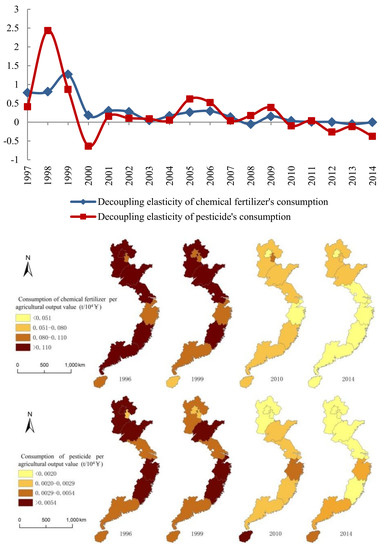Spatial–Temporal Analysis of the Relationships between Agricultural Production and Use of Agrochemicals in Eastern China and Related Environmental and Political Implications (Based on Decoupling Approach and LMDI Decomposition Analysis)
Abstract
:1. Introduction
2. Methodology and Data
2.1. Tapio Decoupling Model
2.2. LMDI Decomposition Model
- (i)
- Agricultural output scale (S) is an important factor of agricultural economic growth. In this function, agrochemical input consumption will increase along with the expansion of agricultural output value under ceteris paribus. It can be called the area factor.
- (ii)
- Agricultural output value per total sown area (Y) is an important symbol for measuring agricultural economic growth. Under the limited agricultural ontology resource, agricultural output value is improved by the improvement of the unit sown area’s utilization. It can be called the effect of the sown area’s benefit, referred to agricultural productivity factor. The variation of agrochemical input consumption can affect the agricultural productivity factor under ceteris paribus.
- (ii)
- Agrochemical input consumption per agricultural output value (I) embodies the efficiency of chemical fertilizer consumption and pesticide consumption in agricultural output value. The higher the agrochemical input efficiency, the less the agrochemical input consumption and agricultural non-point source pollution. The agrochemical input consumption per agricultural output value contains the agrochemical technology level. It can be called the effect of agrochemical efficiency, referred to efficiency factor.
2.3. Research Area and Basic Data
3. Results and Discussion
3.1. Agricultural Development Situation
3.2. Decoupling Relationship between Agrochemical Inputs and Agricultural Economic Growth
- (i)
- The stage of expansive negative decoupling and expansive coupling (during 1996–1999). The decoupling elasticity is basically greater than 0.8, and agricultural economic growth strongly depends on agrochemical inputs. The agrochemical means were quickly expanded under the policy guidance from 1981. The chemical fertilizer consumption was required to increase, and the structure and technology of chemical fertilizer application were required to improve in the 6th five-year plan on national economics and society development of China. This policy was delayed until the 9th five-year plan on national economics and society development of China, which proposed the speeding up of the development of agricultural industry. In spite of the agrochemical input control in certain areas such as Guangdong province which led to the decline of agrochemical input consumption in 1998, but were subject to the influence of policy guidance, it began to rebound in 1999.
- (ii)
- The stage of week decoupling (during 2000–2009). The decoupling elasticity is 0~0.8. Agrochemical input consumption and agricultural output value were basically in the growth phase, and agrochemical input consumption grew more slowly. The year of 2001 is seen as an important year of the source reduction control of agricultural non-point source pollution, because the policies of prevention and control of non-point source pollution were put forward in the 9th five-year plan on national economics and society development of China. In view of the actual situation, the control in Eastern China was executed earlier. It shows that the source reduction control policy of agricultural non-point source pollution gradually played a role, but the dependence on agrochemical to agricultural economic growth was hard to recind quickly.
- (iii)
- The stage of strong decoupling (during 2010–2014). The decoupling elasticity of agrochemical inputs was basically less than zero, especially after the year of 2013, where it shows the status of strong decoupling (αt+1 < 0). The effect of source reduction control on agricultural non-point source pollution has already begun to emerge in this period. Along with the construction of agricultural irrigation and electric infrastructure, the application of agricultural machinery and the development of agricultural technology, the dependence of agricultural economic growth on agrochemical inputs has been weakened. The agrochemical input consumption reduction did not hinder the agricultural economic continuously growth.
3.3. Effect Decomposition of Agrochemical Inputs
3.3.1. LMDI Decomposition of Chemical Fertilizer Converted to Pure Volume
3.3.2. LMDI Decomposition of Pesticide Consumption
3.3.3. Spatial Pattern Change of the Efficiency Factor
4. Conclusions
- (1)
- Continuous developing and adopting of various agricultural efficiency measures. Under the background of continuous reduction in the quantity of agricultural chemical inputs, we must ensure diversified agricultural modernization through ensuring the sustained growth of agricultural output per unit sown area. Accelerate the construction of agricultural water conservancy, electrification and other infrastructure: all provinces and cities should build a rational and manageable agricultural infrastructure according to their respective agricultural landforms. At the same time, we must vigorously promote mechanization of agriculture and develop agricultural machinery targeting at the ease of operation in special agricultural landscapes, based on differences in crop categories, so as to continuously improve the labor efficiency of producers and remedy the influence on agricultural efficiency because of the lack of agrochemical technique.
- (2)
- Continuous improvement in the input and utilization efficiency of agrochemicals. The agricultural non-point source pollution is originally caused by the loss of nutrients in fertilizers and pesticides [26]. Therefore, alongside the strict control of the utilization of agrochemicals, the scientific and technological content during the agrochemical production shall be enhanced, and low pollution and toxicity level agrochemicals shall be preferentially developed, in particular high-efficiency complex fertilizer and low-toxic pesticide. At the same time, the fertilization and soil testing technology based on regional differences, and the pesticide residue absorption and digestion technology based on environmental characteristics shall be developed, to reduce the loss and residue of agrochemicals.
- (3)
- Adopt differentiated regional agricultural chemical input reduction control policy. Different provinces and cities have different economic and environmental resources, and all the provinces and cities should be based on the stage of the agricultural economic development and the present situation of non-point source pollution. According to the resources and environment of the agricultural ontology threshold, we should clarify the key points of control of agricultural chemical input reduction, set up different targets and policies in different regions [44]. In the provinces and cities where agricultural economic growth relies less on the production of agricultural chemicals, we should continue to strengthen the control of agricultural chemical, intensify the re-feeding of industrialization on agricultural modernization and explore the mechanism of inter-regional agricultural transactions. Hainan Province should formulate a corresponding agricultural facilities layout in accordance with the mountainous, hilly and plain landscape features, formulate preferential policies on farm machinery purchase and agricultural electricity utilization, so as to guide the environment-friendly and resource-friendly agriculture with the development of “recycling agriculture” and “low-carbon agriculture”.
Acknowledgments
Author Contributions
Conflicts of Interest
References
- Schaffner, M.; Bader, H.P.; Scheidegger, R. Modeling the contribution of point sources and non-point sources to Thachin River water pollution. Sci. Total Environ. 2009, 407, 4902–4915. [Google Scholar] [CrossRef] [PubMed]
- Collins, A.L.; Anthony, S.G. Predicting sediment inputs to aquatic ecosystems across England and Wales under current environmental conditions. Appl. Geogr. 2008, 28, 281–294. [Google Scholar] [CrossRef]
- Harmel, D.; Potter, S.; Casebolt, P.; Reckhow, K.; Green, C.; Haney, R. Compilation of measured nutrient load data for agricultural land uses in the United States. J. Am. Water Resour. Assoc. 2006, 42, 1163–1178. [Google Scholar] [CrossRef]
- Delpla, I.; Baurès, E.; Jung, A.; Thomas, O. Impacts of rainfall events on runoff water quality in an agricultural environment in temperate areas. Sci. Total Environ. 2011, 409, 1683–1688. [Google Scholar] [CrossRef] [PubMed]
- Yang, L.-Z.; Feng, Y.-F.; Shi, W.-M.; Xue, L.-H.; Wong, S.-Q.; Song, X.-F.; Chang, Z.-Z. Review of the advances and development trends in agricultural non-point source pollution control in China. Chin. J. Eco-Agric. 2013, 21, 96–101. [Google Scholar]
- National Bureau of Statistics of China. Available online: http://www.stats.gov.cn/tjsj/ndsj/ (accessed on 30 January 2018).
- Baumgärtner, S.; Dyckhoff, H.; Faber, M.; Proops, J.; Schiller, J. The concept of joint production and ecological economics. Ecol. Econ. 2001, 36, 365–372. [Google Scholar] [CrossRef]
- Wang, Z.; Xiao, H. Analysis of the effect of fertilizer application on the growth of grain yield. Agric. Econ. Probl. 2008, 8, 65–68. [Google Scholar]
- Grossman, G.M.; Krueger, A.B. Environmental impacts of a North American free trade agreement. Natl. Bur. Econ. Res. 1991. [Google Scholar] [CrossRef]
- Selden, T.M.; Song, D. Environmental quality and development: Is there a Kuznets curve for air pollution estimates? J. Environ. Econ. Manag. 1994, 27, 147–162. [Google Scholar] [CrossRef]
- Pasqual, J.; Souto, G. Sustainability in natural resource management. Ecol. Econ. 2003, 46, 47–59. [Google Scholar] [CrossRef]
- Managi, S. Are there increasing returns to pollution abatement? Empirical analytics of the Environmental Kuznets Curve in pesticides. Ecol. Econ. 2006, 58, 617–636. [Google Scholar] [CrossRef]
- Tsuzuki, Y. An index directly indicates land-based pollutant load contributions of domestic wastewater to the water pollution and its application. Sci. Total Environ. 2006, 370, 425–440. [Google Scholar] [CrossRef] [PubMed]
- Philippe, A.; Howitt, P. A model of growth through creative destruction. Econometrica 1992, 60, 323–351. [Google Scholar]
- Stokey, N.L. Are There Limits to Growth? Int. Econ. Rev. 1998, 39, 1–31. [Google Scholar] [CrossRef]
- OECD (Organization for Economic Cooperation and Development). Indicators to Measure Decoupling of Environmental Pressure from Economic Growth; OECD: Paris, France, 2002. [Google Scholar]
- Tapio, P. Towards a theory of decoupling: Degrees of decoupling in the EU and the case of road traffic in Finland between 1970 and 2001. Transp. Policy 2005, 12, 137–151. [Google Scholar] [CrossRef]
- Abid, M. The close relationship between informal economic growth and carbon emissions in Tunisia since 1980: The (ir)relevance of structural breaks. Sustain. Cities Soc. 2015, 15, 11–21. [Google Scholar] [CrossRef]
- Silvia, C.; Esposti, R. Long-Term Agricultural GHG Emissions and Economic Growth: The Agricultural Environmental Kuznets Curve across Italian Regions. EAAE Congr. Chang. Uncertain. Chall. Agric. 2011, 3, 376–388. [Google Scholar]
- Zhang, Y.; Da, Y. The decomposition of energy-related carbon emission and its decoupling with economic growth in China. Renew. Sustain. Energy Rev. 2015, 41, 1255–1266. [Google Scholar] [CrossRef]
- Sun, J.W. Changes in energy consumption and energy intensity: A complete decomposition model. Energy Econ. 1998, 20, 85–100. [Google Scholar] [CrossRef]
- Ang, B.W.; Choi, K. Decomposition of aggregate energy and gas emission intensities for industry: A refined Divisia index method. Energy J. 1997, 18, 59–73. [Google Scholar] [CrossRef]
- Ang, B.W.; Liu, F.L. A new energy decomposition method: Perfect in decomposition and consistent in aggregation. Energy 2001, 26, 537–548. [Google Scholar] [CrossRef]
- Ang, B.W.; Liu, F.L.; Chew, E.P. Perfect decomposition techniques in energy and environmental analysis. Energy Policy 2003, 31, 1561–1566. [Google Scholar] [CrossRef]
- Ang, B.W.; Zhang, F.Q.; Choi, K. Factorizing changes in energy and environmental indicators through decomposition. Energy 1998, 23, 489–495. [Google Scholar] [CrossRef]
- Zhang, W.; Wu, S.; Ji, H.; Kolbe, H. Estimation of Agricultural Non-Point Source Pollution in China and the Alleviating Strategies I. Estimation of Agricultural Non-Point Source Pollution in China in Early 21 Century. Sci. Agric. Sin. 2004, 37, 1008–1017. [Google Scholar]
- China Food Safety News. Available online: http://paper.cfsn.cn/content/2015-12/15/node_2.htm (accessed on 30 January 2018).
- Jian-Lan, R.; Shu-Min, Z.; Peng, Z. An Ecological Appraisal of Industrial Structure and a thoughtfulness of designing models of Circle Economy in Shandong Province. Sci. Geogr. Sin. 2004, 24, 648–653. [Google Scholar]
- Bin, L.; Ke, W.; Qiang, X.Z. Energy Efficiency Based Regional Cluster Analysis of China. Econ. Geogr. 2013, 33, 15–21. [Google Scholar]
- Cheng, J.; Shi, X. Structural Shift, Techlogical Progress, Energy Price and Energy Efficiency. China Popul. Resour. Environ. 2010, 20, 35–42. [Google Scholar]
- Tao, J. Effects of Cultivated Land Use on Temporal-Spatial Variation of Grain Production in China. J. Nat. Resour. 2014, 29, 911–919. [Google Scholar]
- Li, G.; Li, Z. Empirical analysis on decomposition of carbon emission factors of agricultural energy consumption in China: Based on LMDI model. J. Agro-Tech. Econ. 2010, 10, 66–72. [Google Scholar]
- Yao, C.; Jie, S. Disconnect Analysis and Influence Factors of Animal Husbandry in China. China Popul. Resour. Environ. 2014, 24, 101–107. [Google Scholar]
- National Bureau of Statistics of China. Available online: http://www.yearbookchina.com/naviBooklist-YMCTJ-0.html (accessed on 30 January 2018).
- Zhang, W.; Wu, S.; Ji, H.; Kolbe, H. Estimation of Agricultural Non-Point Source Pollution in China and the Alleviating Strategies III. A Review of Policies and Practices for Agricultural Non-Point Source Pollution Control in China. Sci. Agric. Sin. 2004, 37, 1026–1033. [Google Scholar]
- Xiang, W.; Feng, Z. Analysis on Present Situation and Regional Disparity of Agricultural Chemical Fertilizer Input in China. Acta Agric. Jiangxi 2011, 23, 169–173. [Google Scholar]
- Ministry of Environmental Protection. Ministry of Environmental Protection, National Bureau of Statistics, Ministry of Agriculture. First National Census of Pollution Sources: 2010; Ministry of Environmental Protection: Beijing, China, 2010. [Google Scholar]
- Jiang, L.; Qiu, H.; Yue, J.; Liao, S.P.; Han, W. Decomposition of Factors Contributed to the Increase of China’s Chemical Fertilizer Use and Projections for Future Fertilizer Use in China. J. Nat. Resour. 2013, 28, 1869–1878. [Google Scholar]
- Xue, L.; Yang, L. Recommendations for nitrogen fertiliser topdressing rates in rice using canopy reflectance spectra. Biosyst. Eng. 2008, 100, 524–534. [Google Scholar] [CrossRef]
- Min, J.; Zhang, H.; Shi, W. Optimizing nitrogen input to reduce nitrate leaching loss in greenhouse vegetable production. Agric. Water Manag. 2012, 111, 53–59. [Google Scholar] [CrossRef]
- Yang, J.H. Research on Decoupling Relationship between Agricultural Chemical Inputs and Agricultural Economic Growth: Based on the Data of Six Provinces and One City in East China. J. Nat. Resour. 2017, 32, 1517–1527. [Google Scholar]
- The Shanghai Municipal Agricultural Commission. Available online: http://www.shac.gov.cn/xxgk/xxgkml/snwgzyw/zhongzhi/201509/t20150917_1507579.html (accessed on 30 January 2018).
- Ministry of Agriculture. Available online: http://www.cnagri.com/lypd/lyzx/zaliang/20150703/355708.html (accessed on 30 January 2018).
- Liu, Q. Spatio-temporal changes of fertilization intensity and environmental safety threshold in China. Trans. Chin. Soc. Agric. Eng. 2017, 33, 214–221. [Google Scholar]
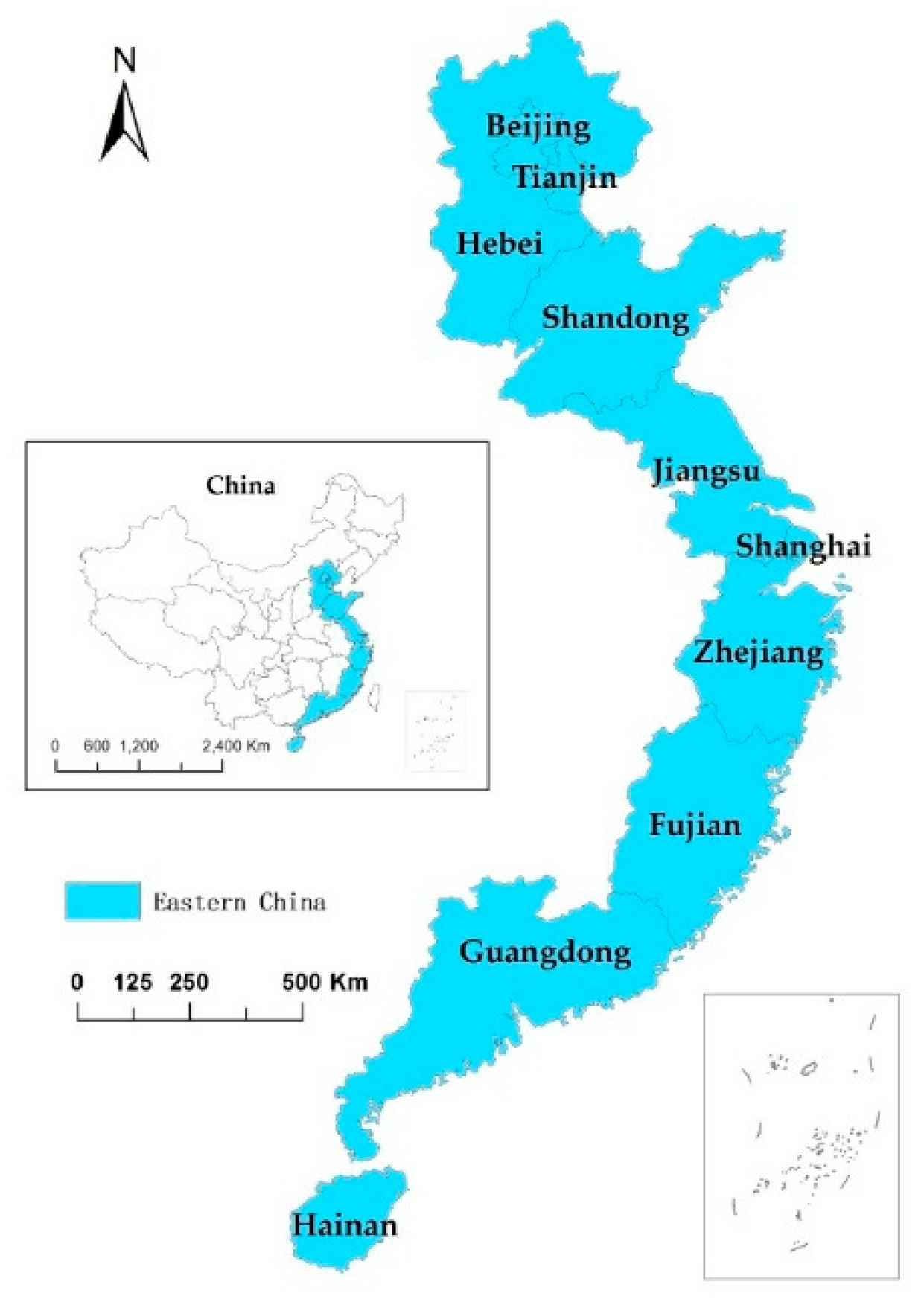
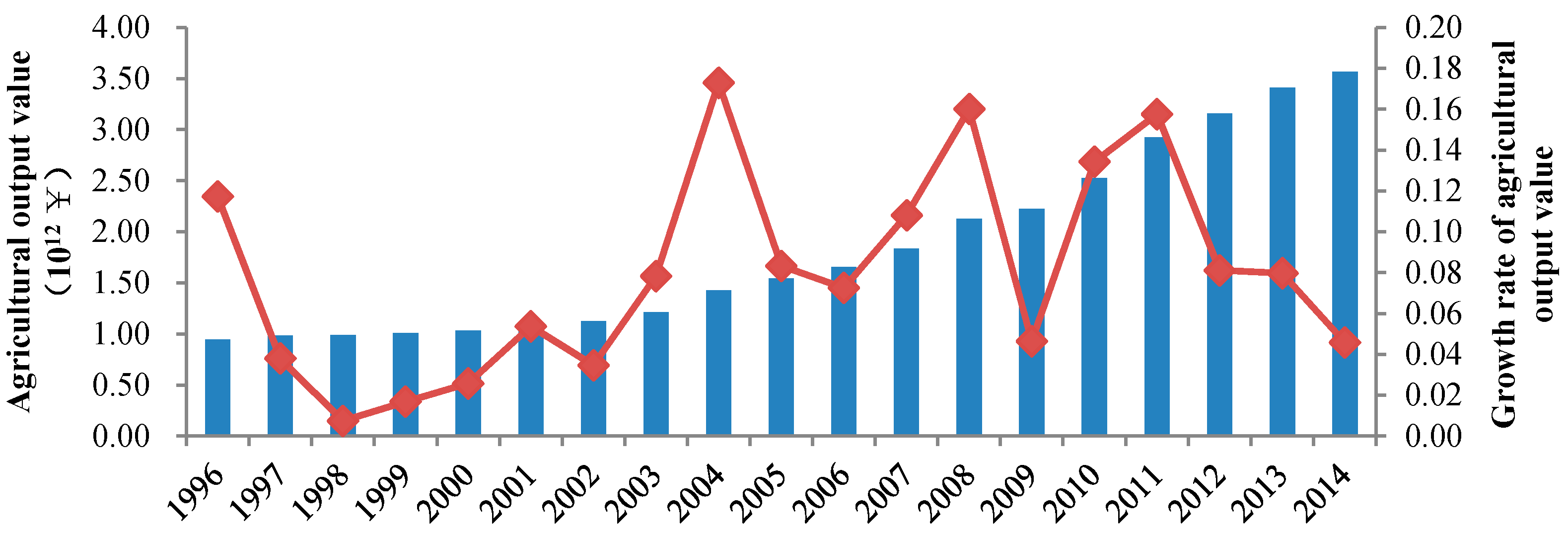
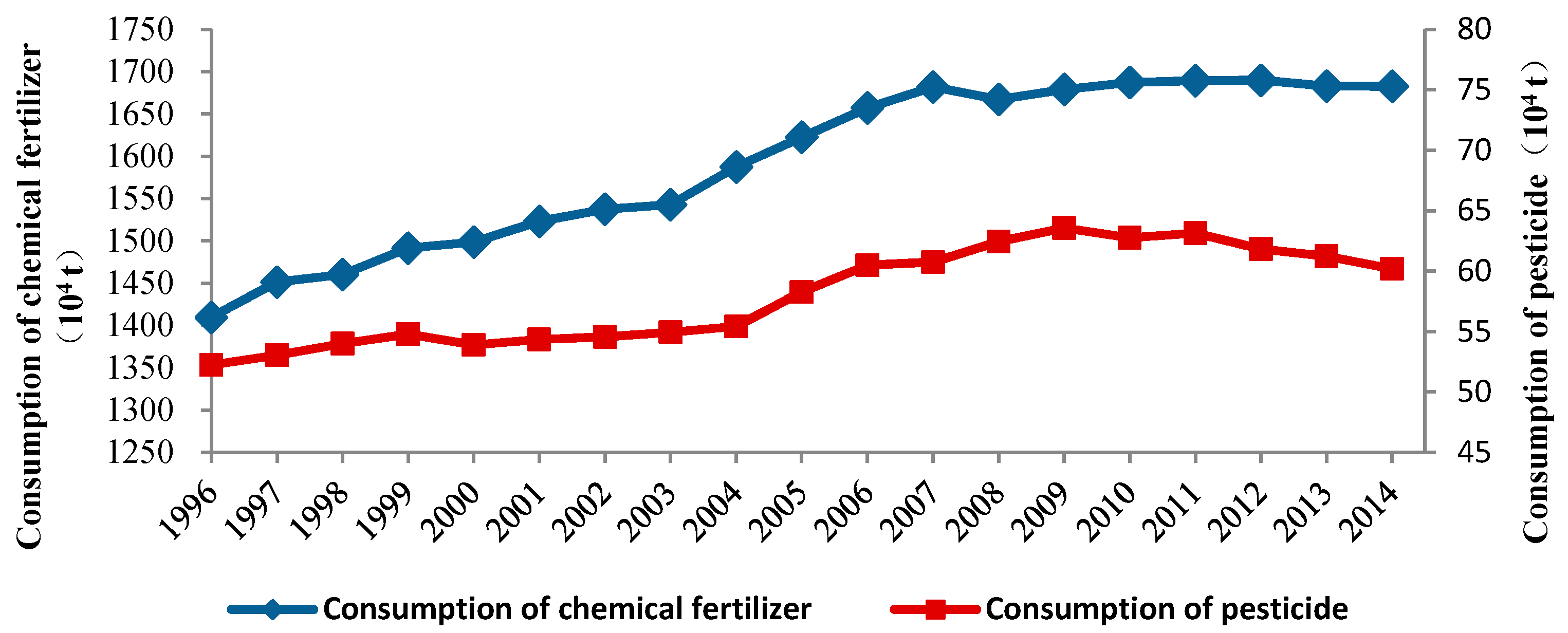


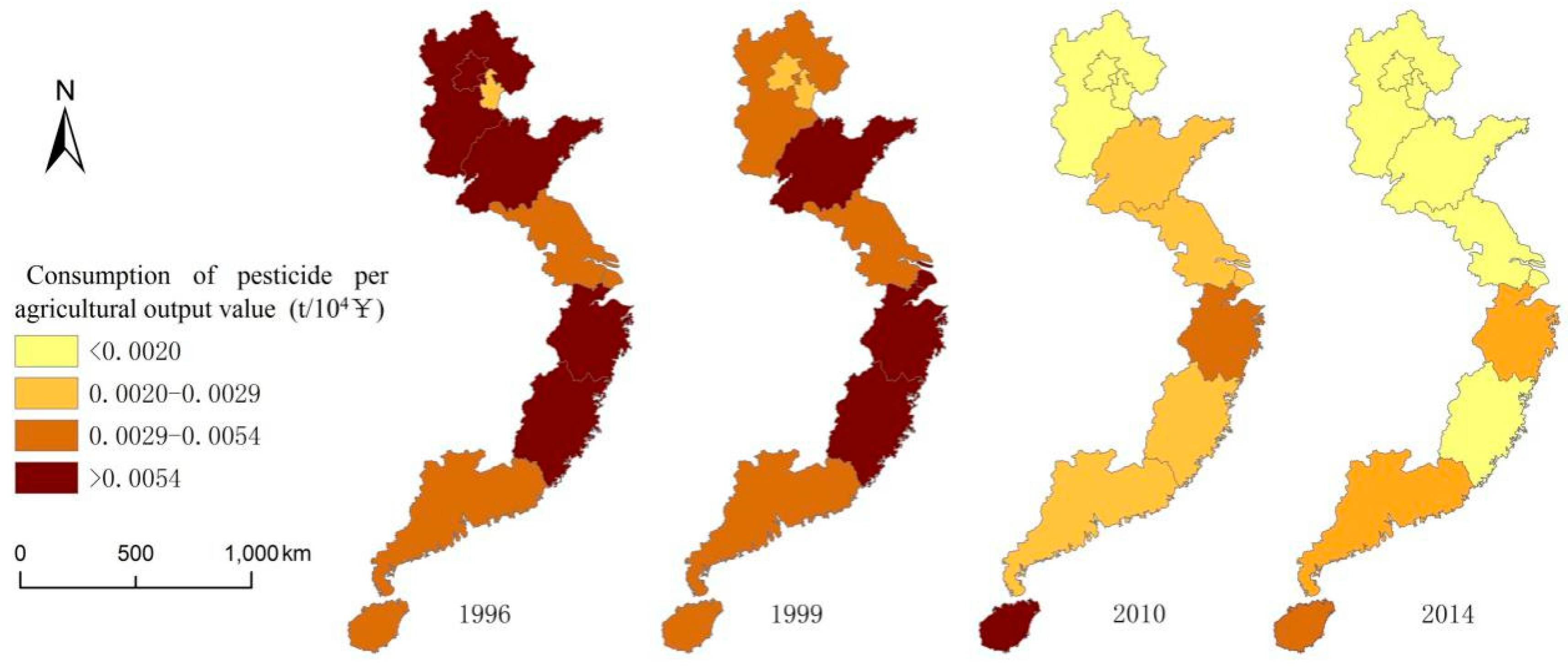
| Year | Consumption of Chemical Fertilizer (104 t) | Consumption of Pesticide (104 t) | Agricultural Output Value (1012 ¥) |
|---|---|---|---|
| 1996 | 1409.50 | 52.24 | 0.95 |
| 1997 | 1451.50 | 53.06 | 0.98 |
| 1998 | 1460.20 | 54.01 | 0.99 |
| 1999 | 1491.50 | 54.80 | 1.01 |
| 2000 | 1498.60 | 53.90 | 1.03 |
| 2001 | 1523.10 | 54.35 | 1.09 |
| 2002 | 1537.60 | 54.55 | 1.13 |
| 2003 | 1542.90 | 54.93 | 1.21 |
| 2004 | 1587.50 | 55.43 | 1.42 |
| 2005 | 1622.62 | 58.28 | 1.54 |
| 2006 | 1657.10 | 60.48 | 1.65 |
| 2007 | 1681.94 | 60.73 | 1.83 |
| 2008 | 1667.20 | 62.44 | 2.13 |
| 2009 | 1679.09 | 63.57 | 2.23 |
| 2010 | 1687.20 | 62.76 | 2.52 |
| 2011 | 1689.30 | 63.14 | 2.92 |
| 2012 | 1689.80 | 61.82 | 3.16 |
| 2013 | 1682.90 | 61.24 | 3.41 |
| 2014 | 1682.70 | 60.18 | 3.57 |
| Period | Consumption of Chemical Fertilizer (104 t) | Consumption of Pesticide (104 t) | ||||||
|---|---|---|---|---|---|---|---|---|
| Area Factor | Agricultural Productivity Factor | Efficiency Factor | Total Change | Area Factor | Agricultural Productivity Factor | Efficiency Factor | Total Change | |
| 1996–1997 | 5.55 | 22.74 | −19.74 | 8.55 | 0.2 | 0.84 | −0.23 | 0.82 |
| 1997–1998 | 16.98 | 19.25 | −5.35 | 30.88 | 0.62 | 0.71 | −0.38 | 0.95 |
| 1998–1999 | −14.52 | 39.14 | −17.61 | 7.01 | −0.54 | 1.44 | −0.12 | 0.79 |
| 1999–2000 | −28.82 | 66.84 | −13.78 | 24.24 | −1.05 | 2.43 | −2.28 | −0.9 |
| 2000–2001 | −20.2 | 99.27 | −64.75 | 14.32 | −0.72 | 3.56 | −2.38 | 0.45 |
| 2001–2002 | −31.16 | 83.31 | −46.88 | 5.27 | −1.11 | 2.97 | −1.61 | 0.25 |
| 2002–2003 | −40.92 | 157.02 | −72.21 | 43.89 | −1.46 | 5.59 | −3.72 | 0.41 |
| 2003–2004 | −16.75 | 266.28 | −215.28 | 34.25 | −0.59 | 9.4 | −8.39 | 0.42 |
| 2004–2005 | 5.72 | 122.64 | −94.61 | 33.75 | 0.2 | 4.34 | −1.69 | 2.85 |
| 2005–2006 | 0.2 | 114.55 | −90.35 | 24.4 | 0.01 | 4.15 | −1.96 | 2.2 |
| 2006–2007 | −70.52 | 241.84 | −186.01 | −14.7 | −2.56 | 8.78 | −5.97 | 0.25 |
| 2007–2008 | 17.08 | 231.54 | −258.8 | −10.18 | 0.63 | 8.51 | −7.44 | 1.7 |
| 2008–2009 | 8.62 | 67.34 | −53.9 | 22.06 | 0.32 | 2.54 | −1.72 | 1.14 |
| 2009–2010 | 8.29 | 203.8 | −203.98 | 8.11 | 0.31 | 7.65 | −8.77 | −0.81 |
| 2010–2011 | 8.1 | 238.87 | −244.87 | 2.1 | 0.3 | 8.91 | −8.83 | 0.38 |
| 2011–2012 | −4.86 | 136.61 | −131.25 | 0.5 | −0.18 | 5.05 | −6.19 | −1.32 |
| 2012–2013 | 5.75 | 123.51 | −136.16 | −6.9 | 0.21 | 4.51 | −5.3 | −0.58 |
| 2013–2014 | 0.97 | 74.47 | −75.65 | −0.2 | 0.04 | 2.69 | −3.77 | −1.05 |
| 1996–2014 | −149.5 | 2194.57 | −1817.16 | 227.92 | −5.44 | 79.86 | −66.48 | 7.94 |
© 2018 by the authors. Licensee MDPI, Basel, Switzerland. This article is an open access article distributed under the terms and conditions of the Creative Commons Attribution (CC BY) license (http://creativecommons.org/licenses/by/4.0/).
Share and Cite
Lin, Y.; Yang, J.; Ye, Y. Spatial–Temporal Analysis of the Relationships between Agricultural Production and Use of Agrochemicals in Eastern China and Related Environmental and Political Implications (Based on Decoupling Approach and LMDI Decomposition Analysis). Sustainability 2018, 10, 917. https://doi.org/10.3390/su10040917
Lin Y, Yang J, Ye Y. Spatial–Temporal Analysis of the Relationships between Agricultural Production and Use of Agrochemicals in Eastern China and Related Environmental and Political Implications (Based on Decoupling Approach and LMDI Decomposition Analysis). Sustainability. 2018; 10(4):917. https://doi.org/10.3390/su10040917
Chicago/Turabian StyleLin, Yaoben, Jianhui Yang, and Yanmei Ye. 2018. "Spatial–Temporal Analysis of the Relationships between Agricultural Production and Use of Agrochemicals in Eastern China and Related Environmental and Political Implications (Based on Decoupling Approach and LMDI Decomposition Analysis)" Sustainability 10, no. 4: 917. https://doi.org/10.3390/su10040917
APA StyleLin, Y., Yang, J., & Ye, Y. (2018). Spatial–Temporal Analysis of the Relationships between Agricultural Production and Use of Agrochemicals in Eastern China and Related Environmental and Political Implications (Based on Decoupling Approach and LMDI Decomposition Analysis). Sustainability, 10(4), 917. https://doi.org/10.3390/su10040917




